Physical Address
304 North Cardinal St.
Dorchester Center, MA 02124
The features of a breast cancer on routinely fixed, processed and stained histopathological sections provide, not only the basis for diagnosis of the disease, but also invaluable prognostic information. Predictive biomarkers are subsequently assessed on the tissue facilitating selection of the most appropriate therapies for the individual patient. Accurate provision of all these pieces of information requires good multidisciplinary communication between radiologists, surgeons and pathologists, along with thorough and careful handling of specimens, quality-assured laboratory processes and timely pathology reporting, ideally by an individual with an interest and expertise in breast diseases. Adherence to national breast pathology guidelines and minimum dataset reporting, including the use of proformas, ensures that all relevant features are recorded accurately. In this chapter the most important pathological features of a breast cancer are outlined and their clinical relevance is considered.
The Royal College of Pathologists guidance ‘Pathology reporting of breast disease in surgical excision specimens, incorporating the dataset for histological reporting of breast cancer’ provides recommendation on all aspects of breast surgical specimen handling, assessment and reporting.
The importance of providing a full clinical history, previous diagnoses and treatments on the pathology request form submitted with any specimen to the laboratory is often neglected. Sufficient (and correct) details directly influence how each specimen is handled and sampled by the pathologist and the laboratory. Ideally, these details should include the nature, extent and location of the lesion(s), particularly if multiple; whether any neoadjuvant therapy was received; and previous biopsy results (especially if not reported or reviewed in-house). For example, if the pathologist is not aware that the patient has received neoadjuvant therapy, they will not provide an assessment of degree of response in the histology report. In all cases, the pathologist will assume that a therapeutic specimen has been resected according to the Surgical Guidelines for the Management of Breast Cancer (Association of Breast Surgeons at British Association of Surgical Oncology 2009) and that all the tissue from subcutaneous fat down to the pectoral fascia is included, and will select blocks to examine microscopically concentrating on radial margins. If the excision differs, for example if the deep aspect is a ‘true’ surgical margin, and the pathologist is aware of this, a more complete assessment of this margin will be performed.
Specimen orientation, preferably with diagrams, helps ensure correlation of surgical resection margins with pathological findings, and is especially important if more than one piece of tissue is excised. Orientated specimen X-rays of wide excision specimens assist in radiological–pathological correlation and help the pathologist to identify areas of concern for tissue sampling. Specimen, and specimen slice, x-rays of mastectomy specimens are particularly valuable in cases with calcifications and in those with excellent response to neoadjuvant therapy, so that the pathologist can focus on the relevant areas for examination. There are a variety of methods the surgeon can use to orientate a sample (e.g. different numbers of sutures or clips, the latter with the advantage of visibility on specimen X-ray), and it is recommended that an agreed local protocol be followed. Finally, in order to ensure adequate fixation (which is essential for assessment of a variety of prognostic and predictive markers), specimens should be sent as soon as possible, ideally fresh, to the pathology laboratory for incision and placed into neutral buffered formalin (and biobanking, if appropriate). In situations where immediate transfer is impossible, a discussion should be held between surgeons and pathologists and the following options considered: injecting mastectomy specimens with neutral buffered formalin. This requires some expertise and an appropriate and well-ventilated room where the whole specimen is injected to ensure the mastectomy specimen is well preserved for later examination. Another option is the surgeon incising mastectomy specimens from the posterior aspect in the fresh state, although this should not be performed without consultation; routine incision of breast conservation surgical specimens without such multidisciplinary discussion is not recommended as it will affect the ability of the pathologist to assess, measure and report the distance to margins.
When received in the laboratory, the surface of the specimen is inked. There are a variety of inks that can be used, but in many centres multiple colours are applied so that the different margins can be distinguished microscopically ( Fig. 4.1 ). The specimen is then weighed and measured in three dimensions, so that the volume of excised tissue can be estimated. Wide local excisions (WLEs) for breast carcinoma are then generally sliced in one of two ways: from one end to the other (e.g. medial to lateral, superior to inferior or anterior to posterior) into slices of equal thickness, each typically 3–5 mm thick (‘bread-slicing’), or the WLE is ‘cruciated’ (the latter shown in Fig. 4.2 ). In general, each pathologist has a personal preference, but different specimens will be approached in different ways according to the lesion(s) present. Portions taken for subsequent microscopic examination will include representative sections of the tumour, and each of the radial resection margins. These pieces of tissue are usually approximately 3 mm thick and 15 × 20 mm in surface area, i.e. to fit into a pathology ‘cassette’.
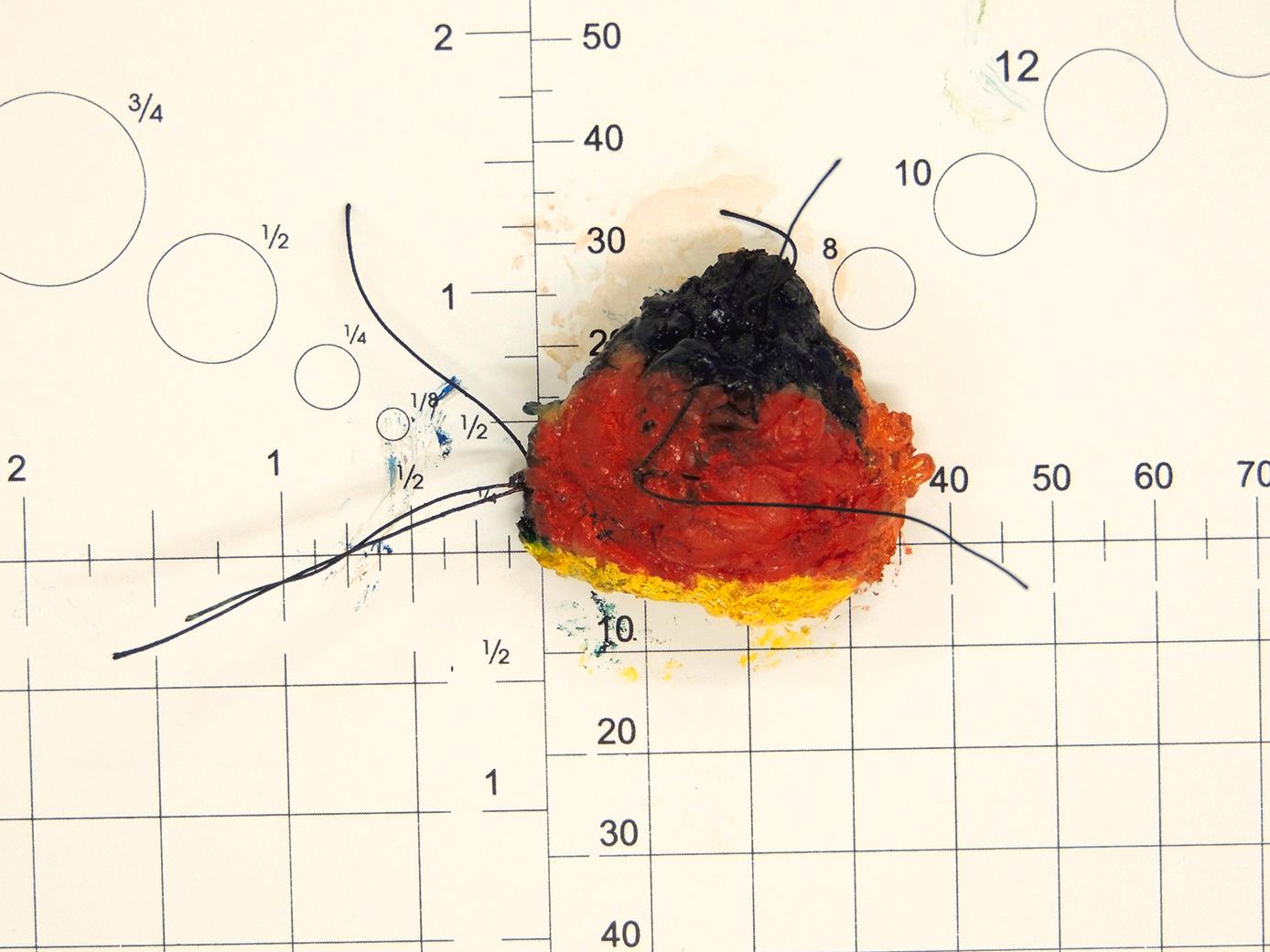
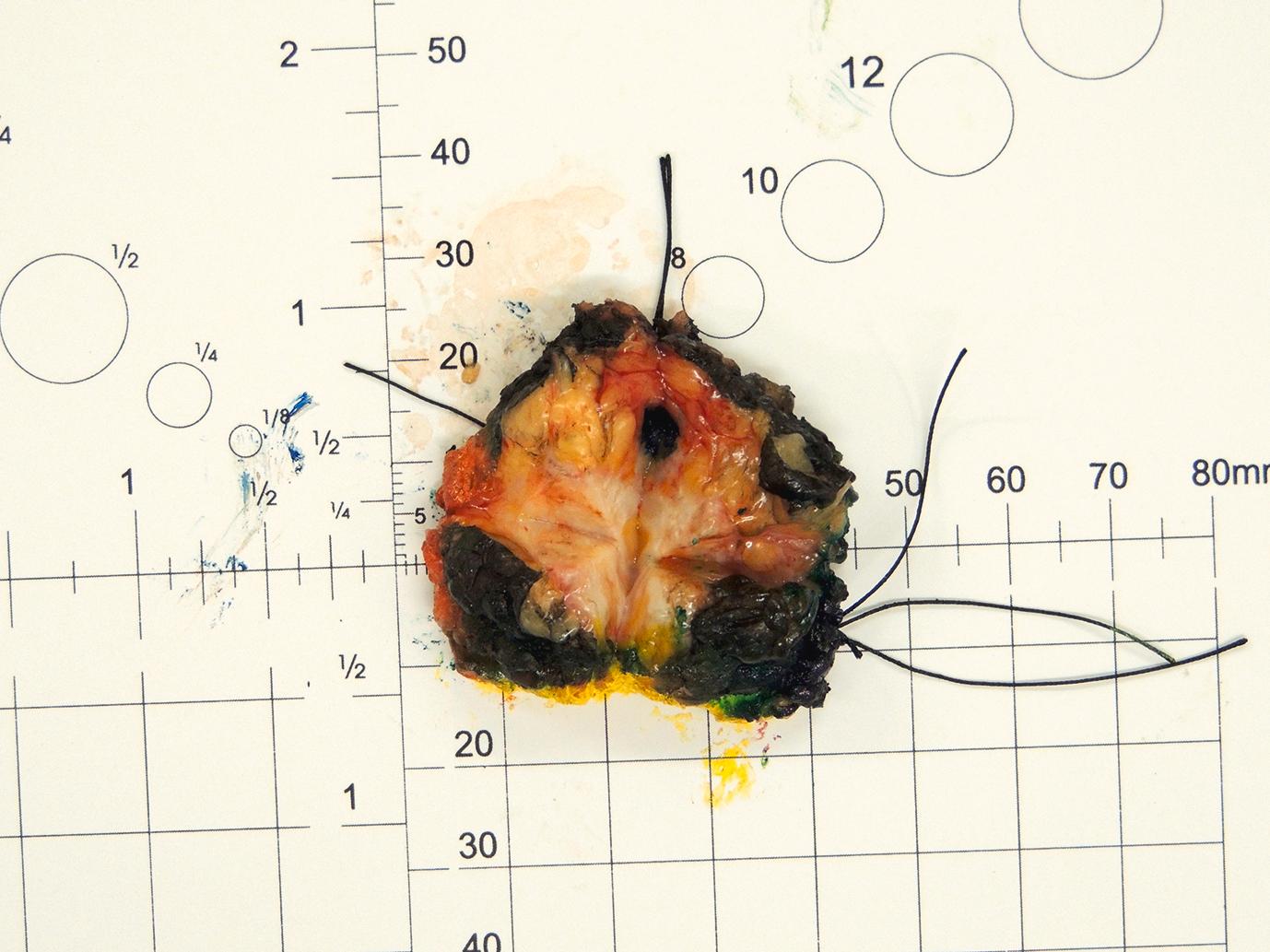
Some pathologists prefer the cruciate method for mass lesions as the largest dimension of the tumour, as well as all relevant margins, can often be sampled in just four standard cassettes if the tumour/specimen is not large; the tumour extending in each of the four radial dimensions and the adjacent radial margin will be incorporated into one block each. Conversely, specimens without a mass lesion (e.g. ductal carcinoma in situ [DCIS] presenting as mammographic microcalcification) typically require ‘bread-slicing’ and X-ray of the specimen slices to facilitate block selection. Overall, the choice of method is at the discretion of the sampling pathologist and local protocols. Some laboratories have the facility to use so-called ‘megablocks’ into which larger portions of tissue can be placed, often a full slice across a WLE, enabling all radial margins and the tumour dimensions to be assessed on one large slide.
For mastectomies a variety of approaches are used. For palpable tumours, some pathologists slice the specimen in a cruciate fashion (as for WLEs), whilst others ‘bread-slice’ the entire mastectomy into equal slices (typically 5–10 mm thick). Representative slices of the tumour and any macroscopic lesions are sampled. According to local protocol, the anterior and deep margins and also blocks from different quadrants and the nipple are sampled, albeit that in the absence of any macroscopic abnormality these provide information of limited clinical relevance. For example if any small, unanticipated additional satellite foci of carcinoma or Paget’s disease of the nipple are identified, these are likely to have been completely excised and so are unlikely to have any clinical impact. Thus the main focus should be on adequate tumour sampling.
The aim of the macroscopic examination is to ensure that blocks taken for microscopic examination facilitate provision of the core data required for diagnosis, cancer staging, prognostication and subsequent patient management. The Royal College of Pathologists pathology minimum dataset (summarised in Table 4.1 ) includes invasive carcinoma size or size of ‘pure’ DCIS or pleomorphic lobular carcinoma in situ (LCIS); whole tumour size (maximum extent of invasive carcinoma with surrounding DCIS [or pleomorphic LCIS – PLCIS]); histological tumour type; grade; presence or absence of lymphovascular invasion (LVI); number of ‘positive’ lymph nodes (LNs) and total number of LNs examined; residual disease and degree of response if neoadjuvant therapy has been received; distance to all margins (of invasive carcinoma and of DCIS); oestrogen receptor (ER) and human epidermal growth factor receptor 2 (HER2) status; and finally, staging. Each of these is discussed briefly in further detail in the following.
| Feature | Recorded as | Comment |
|---|---|---|
| Invasive carcinoma size | Size in mm | |
| Whole tumour size (extent of invasive tumour and associated DCIS) | Size in mm | |
| Disease extent | Localised or multiple foci | |
| Tumour type | Special type (various, to be recorded) or mixed | |
| Histological grade | 1, 2 or 3 | Components of grade are optionally reported, but provide useful information for review if grade distribution is unusual in any centre |
| Lymphovascular invasion | Present, absent or possible | |
| Lymph node stage | Total present, total positive | For single lymph node positivity, presence of macrometastasis, micrometastasis or isolated tumour cells is recorded |
| TNM stage | Required by Cancer Registries and Cancer Outcomes and Services Dataset (COSD) | |
| Excision margin | Distance to margins in mm | To include superior, inferior, medial, lateral, deep and superficial |
| Oestrogen receptor status | Positive (1% or more of tumour cells) or negative | Presence of control material on the slide should be noted |
| HER2 status | Positive or negative | Immunohistochemistry score (0, 1, 2 or 3) and, if performed, ISH ratio and HER2 and chromosome 17 copy number |
In situ carcinoma is a clonal proliferation retained by a myoepithelial layer and an intact basement membrane. DCIS is widely regarded as a non-obligate precursor, with a variable risk of progression to invasive disease. The clinical significance of classical-type LCIS is more controversial but it is generally regarded as a risk lesion rather than a true precursor of invasive disease.
DCIS comprises 5% of symptomatic disease (in historical series) but ∼20–25% of screen-detected breast cancer. It is typically identified as rod-shaped, branching or granular microcalcifications on screening mammography. The former are most often associated with high-grade DCIS, the latter with low-grade disease, due to calcification within necrotic debris or secretions, respectively. Because of this radiological detection, i.e. without an associated palpable mass, identifying DCIS at cut-up in the laboratory in a surgical specimen may be challenging. Pale specks representing comedo-type necrosis may provide a clue as to where the lesion lies in the macroscopic specimen, but specimen slice radiography is recommended in most cases to ensure accurate sampling (unless, for example, the specimen is sliced and embedded/examined in its entirety).
DCIS arises from the terminal duct-lobular unit of the breast and typically arborises within one duct territory (‘unicentric’) without forming a discrete mass. However, normal breast duct territories vary a great deal in size and shape and their extent overlaps and interweaves with other territories. Partly as a consequence of this, two-dimensional histological examination can lead to misinterpretation of a unifocal area of DCIS involving a complex single duct territory as multisite or multifocal DCIS. Microscopically, atypical neoplastic populations of cells are seen within ducts, sometimes extending into lobules (‘cancerisation’). DCIS can show a variety of architectural growth patterns within the terminal duct lobular unit and associated ducts (e.g. solid, cribriform, micropapillary, papillary), although different patterns may coexist. DCIS is graded into low, intermediate and high grade types, according to nuclear size and nuclear pleomorphism, with, in the UK, most (64%) being high-grade disease. Cytonuclear grade has been shown both to be relatively reproducible and to correlate with clinical outcome in most series. Of note, necrosis ( Fig. 4.3 ) is more common in high cytonuclear grade DCIS but may be present in lower grades of disease.
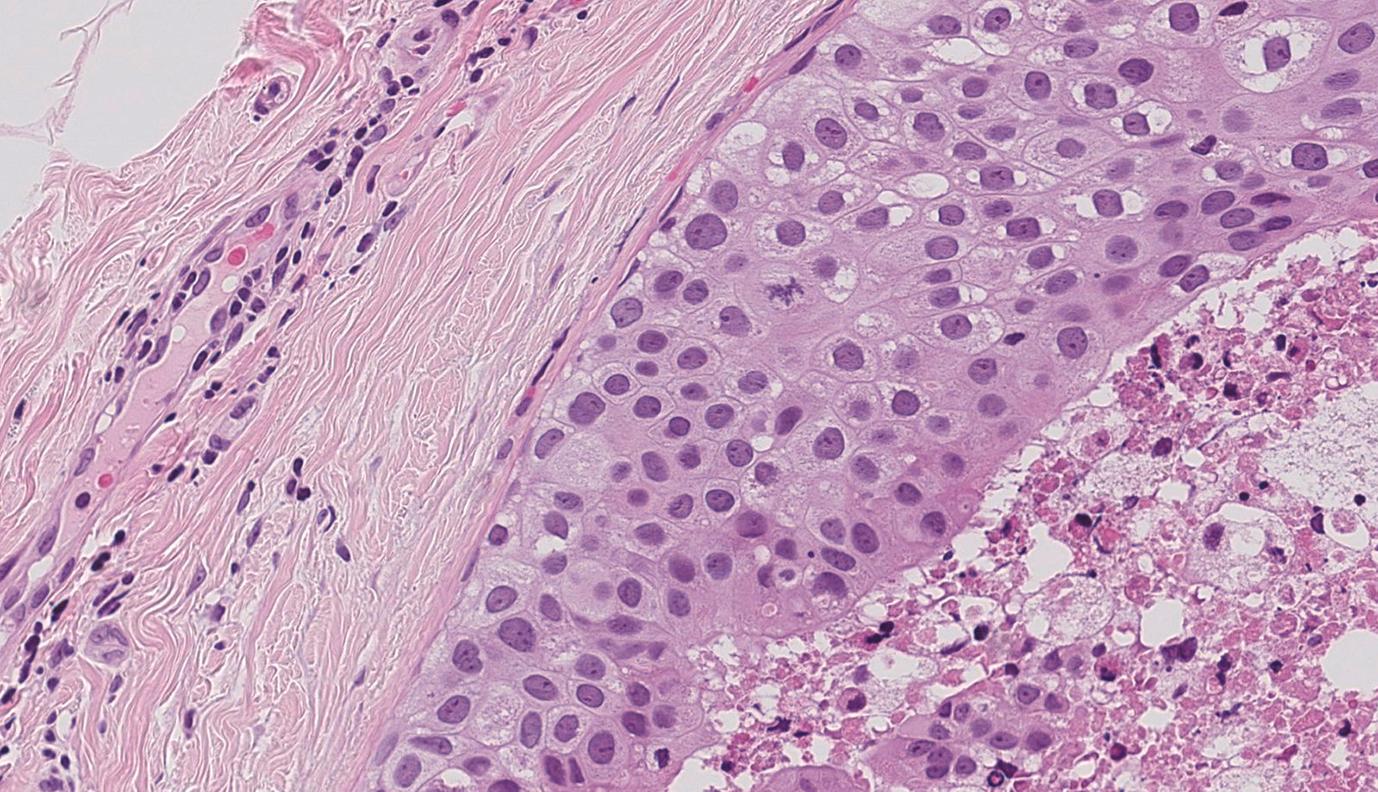
At present, surgical excision remains the mainstay of treatment for DCIS. Therapeutic excision specimens for DCIS are challenging for the pathologist; as outlined earlier, the lesion may not be evident macroscopically and the excision margin widths cannot be identified by eye. Such specimens therefore often require slicing, specimen slice X-ray examination and extensive sampling. Determining the margin status of DCIS is particularly demanding, because of the three-dimensional growth pattern of this disease. In addition, there is no international consensus regarding the definition of an adequate margins of clearance; a meta-analysis suggested that a margin of excision of 2 mm for DCIS should be obtained, , but in this analysis there was no direct comparison of 1 mm vs 2 mm margins, as the numbers in these categories were too small for a meaningful comparison. The issue of margins is addressed further in the breast conservation and DCIS chapter ( Chapters 7 and 13 ). Some centres have reported low recurrence rates with a 1 mm margin regarded as ‘complete’ excision, with the additional of radiotherapy in high-grade DCIS, and without radiotherapy in low- and intermediate-grade lesions.
In older series of patients with DCIS, and in several randomised clinical trials, approximately half of DCIS recurrences were in the form of invasive cancer. DCIS recurrence appears sooner than invasive ipsilateral disease and ipsilateral DCIS events reduce in frequency after 5 years, while the risk of ipsilateral invasive cancer remains consistent to 10 years and beyond. This may be because DCIS ‘recurrence’ is perhaps somewhat of a misnomer, with studies suggesting that this so-called recurrence represents residual disease/incomplete excision, rather than a true new synchronous malignancy.
![]() Shaaban et al. found that among 11 337 patients in the Sloane Project audit, 7204 (64%) had high-grade DCIS. The proportion of high-grade disease increased (from 60% to 65%) over time (2003–2012), whilst low-grade DCIS decreased as a proportion (from 10% to 6%). Of 9191 women diagnosed in England (median follow-up 9.4 years), 7% developed DCIS or invasive malignancy in the ipsilateral and 5% in the contralateral breast. Recurrence as ipsilateral invasive carcinoma ( n = 413; median time 62 months) was more frequent than ipsilateral DCIS ( n = 225; median 37 months). Few (6%) patients treated with WLE had a surgical margin <1 mm.
Shaaban et al. found that among 11 337 patients in the Sloane Project audit, 7204 (64%) had high-grade DCIS. The proportion of high-grade disease increased (from 60% to 65%) over time (2003–2012), whilst low-grade DCIS decreased as a proportion (from 10% to 6%). Of 9191 women diagnosed in England (median follow-up 9.4 years), 7% developed DCIS or invasive malignancy in the ipsilateral and 5% in the contralateral breast. Recurrence as ipsilateral invasive carcinoma ( n = 413; median time 62 months) was more frequent than ipsilateral DCIS ( n = 225; median 37 months). Few (6%) patients treated with WLE had a surgical margin <1 mm.
LCIS also arises from the terminal duct lobular unit. The cells of classical LCIS are characteristically discohesive and moderate in size, much like the cells of invasive lobular carcinoma (ILC). LCIS is distinguished from atypical lobular hyperplasia (ALH) by the extent of disease within the terminal duct lobular unit; more than 50% of the total number of acini in a terminal duct lobular unit must be expanded by the atypical cells for a diagnosis of LCIS whilst lesser degrees are regarded as ALH ( Fig. 4.4 ). Some recommend that the term ‘lobular in situ neoplasia’ (LIN) be used for either process, as both ALH and LCIS have the same cytological and molecular changes. Indeed, when extent cannot be reliably assessed (e.g. in core biopsy), it is recommended that the process be classified as lobular neoplasia, but in surgical excision specimens ALH should be distinguished from LCIS, as the risk of development of invasive carcinoma is greater with LCIS (increased risk approx. 10×) than ALH (increased risk approx. 4×). LCIS is less commonly diagnosed than DCIS; data from the Sloane project in the UK suggest that one diagnosis of LCIS is made for every 25 diagnoses of DCIS. This is largely because classical LCIS is most often a coincidental finding identified histologically, rather than a screen-detected or mass-forming lesion.
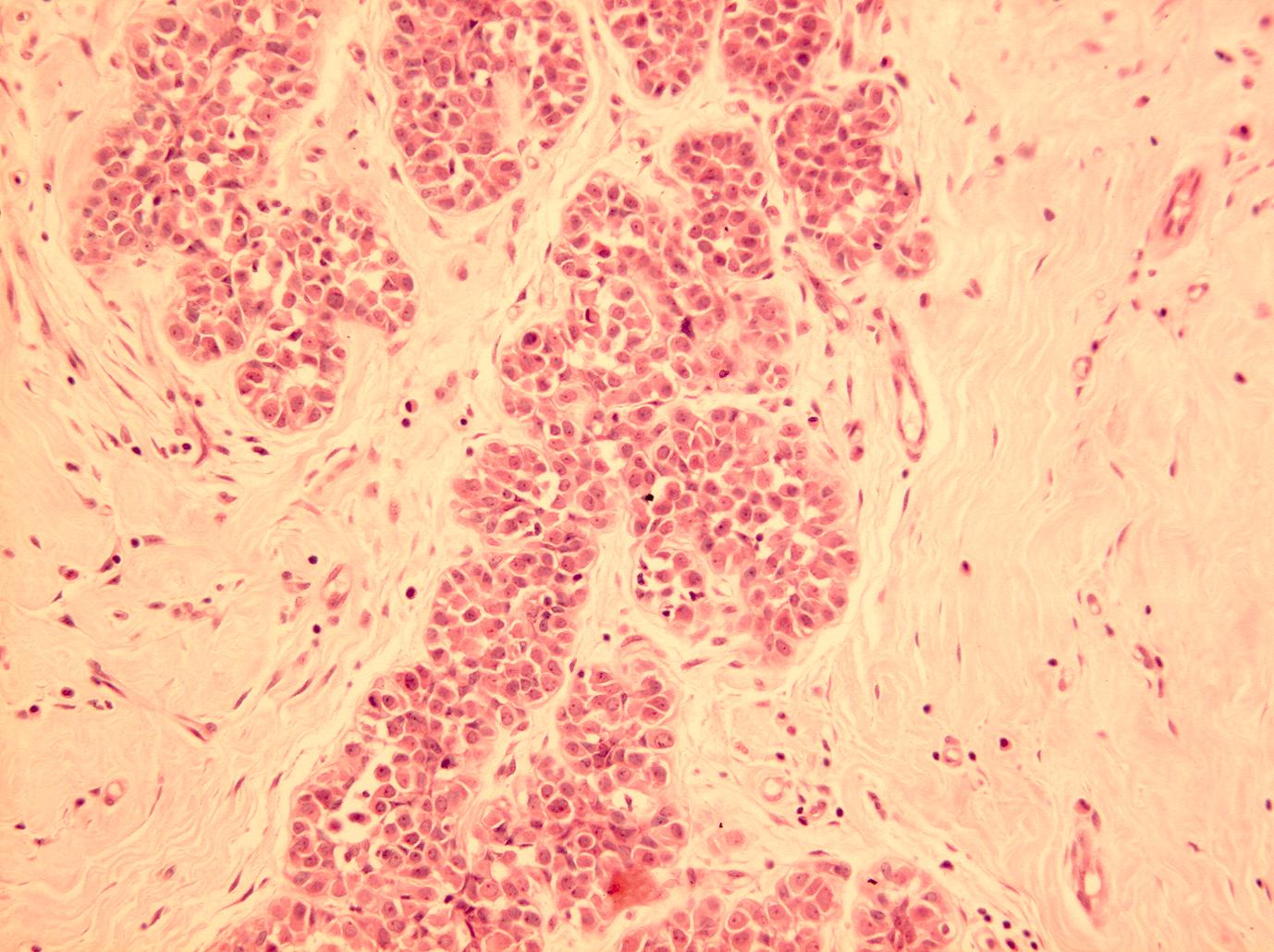
PLCIS is an uncommon variant of LCIS and is formed of cells that show similar discohesion and growth pattern to the classical form but which are of high cytonuclear grade ( Fig. 4.5 ). Comedo necrosis, with or without microcalcification, is often present and this lesion is typically detected on mammographic screening with calcifications. Although there are still limited clinical data on the behaviour and optimum management of PLCIS, the more aggressive biological features of the disease (e.g. morphology, proliferation rate and expression of HER2 more often than in classical LCIS) and the higher incidence of concurrent invasive cancer when compared to classical LCIS both suggest that this may behave more like DCIS. At present, therefore, PLCIS is typically managed akin to DCIS and the extent of PLCIS should be recorded in excision specimens, and distance to margins included in histology reports.
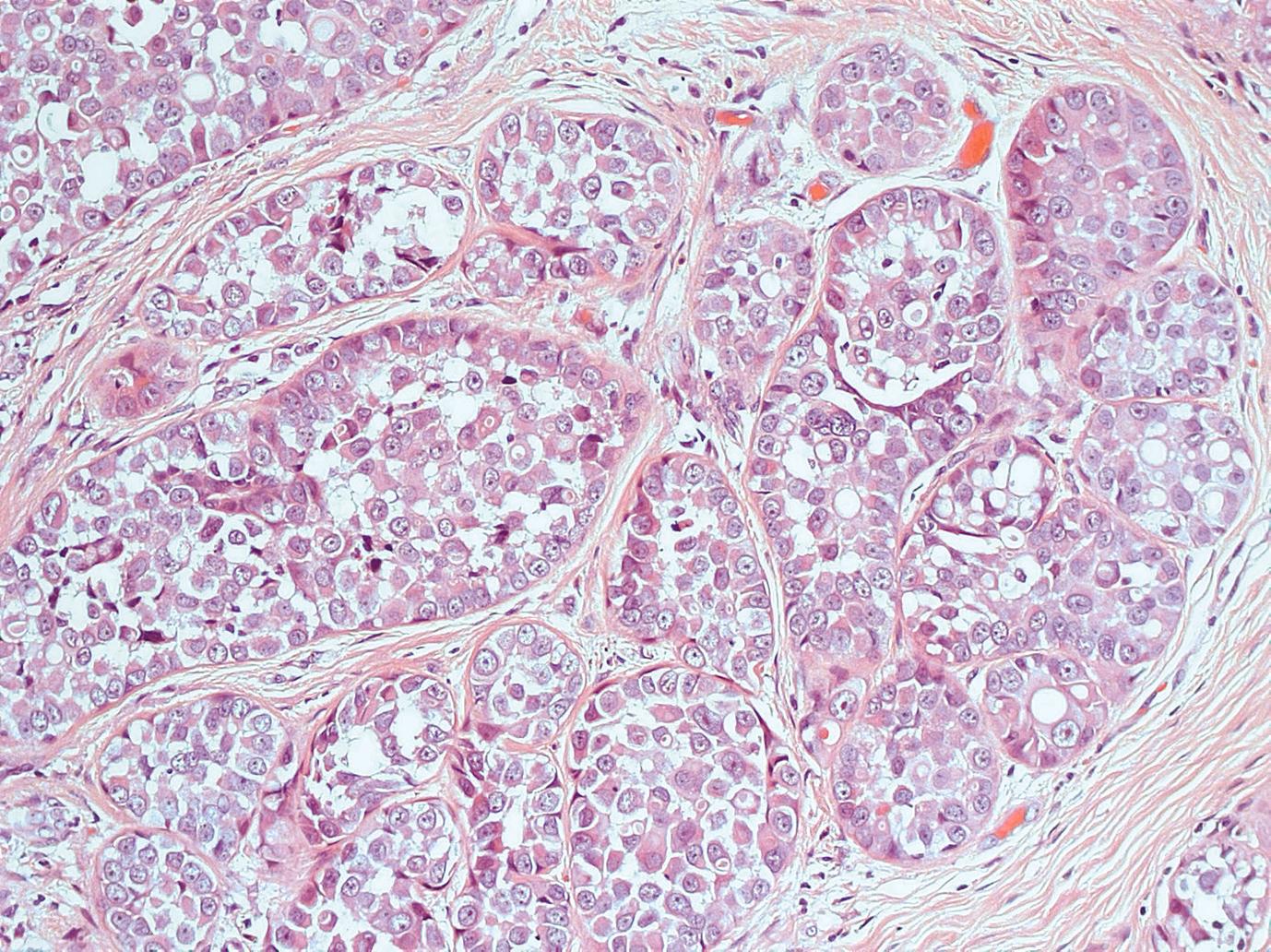
Florid LCIS is a rarer variant of LCIS characterised by marked expansion of acini (40–50 cells across) with a population of cells with the same cytology as in classical LCIS but forming a confluent mass-like lesion. As in the pleomorphic form, there may be central necrosis and calcifications detected mammographically and seen histologically. As for PLCIS, management of florid LCIS reflects that of DCIS and, if WLE is performed, the current consensus is that clear margins should be the aim. It is noteworthy that both PLCIS and florid LCIS are reported to be unifocal and are often co-localised with invasive carcinoma, suggesting that these lesions demonstrate true (non-obligate) precursor behaviour.
Invasive breast carcinoma is recognised when there is extension of carcinoma beyond the basement membrane and the invasive element is more than 1 mm in size. Microinvasive carcinoma is diagnosed when one or more separate foci of invasion measure 1 mm or less in maximum dimension. Microinvasion is typically seen in the context of extensive high-grade DCIS, but is uncommon and must be distinguished from other mimics, such as cancerisation of lobules or of sclerosing adenosis, by DCIS.
The main features of an invasive breast cancer are assessed histologically in two main ways: histological subtype and histological grade ; both provide biological and prognostic information.
A large number of morphological subtypes of invasive breast cancer are recognised. By definition, tumours of a ‘special type’ show the classical morphological features of that particular type in at least 90% of the tumour. Tumours of special type tend to have a more favourable prognosis than no special type (NST) lesions, but this is not invariably the case.
Invasive carcinomas of NST ( Fig. 4.6 ) have no special features or comprise less than 50% of special type morphology. Historically these were called ‘ductal’, but as these are neither derived from ducts nor necessarily form ducts, the term ‘ductal’ is no longer recommended. The entity of NST invasive breast carcinoma is one of exclusion; these lesions show no special diagnostic features but they account for the majority (up to 75%) of invasive breast cancers. Nevertheless, NST cancers vary in histology and clinical behaviour and, as for all invasive breast cancers, additional methods for stratification, such as histological grade, are essential.
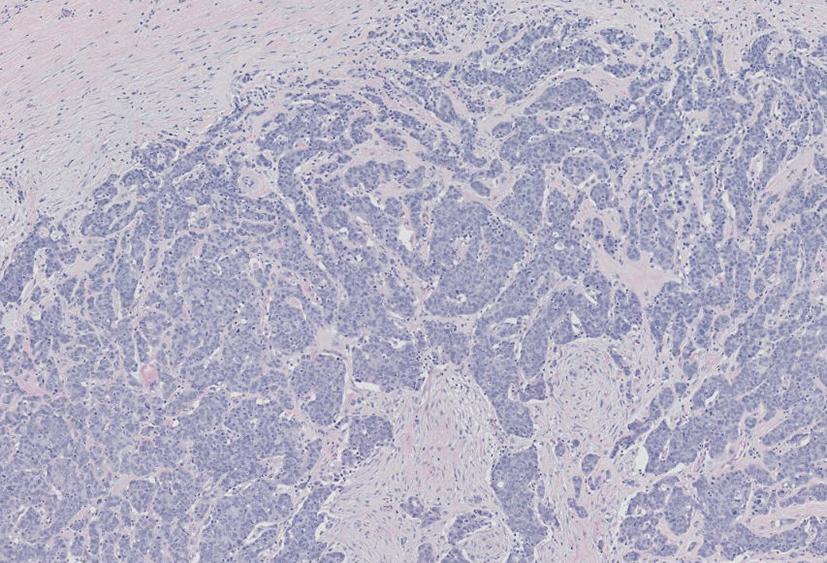
Between the extremes of NST and special type cancers, some invasive cancers are classified as mixed tumours because they contain some special type areas (more than 50%, but less that 90%) in various combinations ; e.g. there may be areas of mucinous carcinoma admixed with areas of NST ( Fig. 4.7 ).
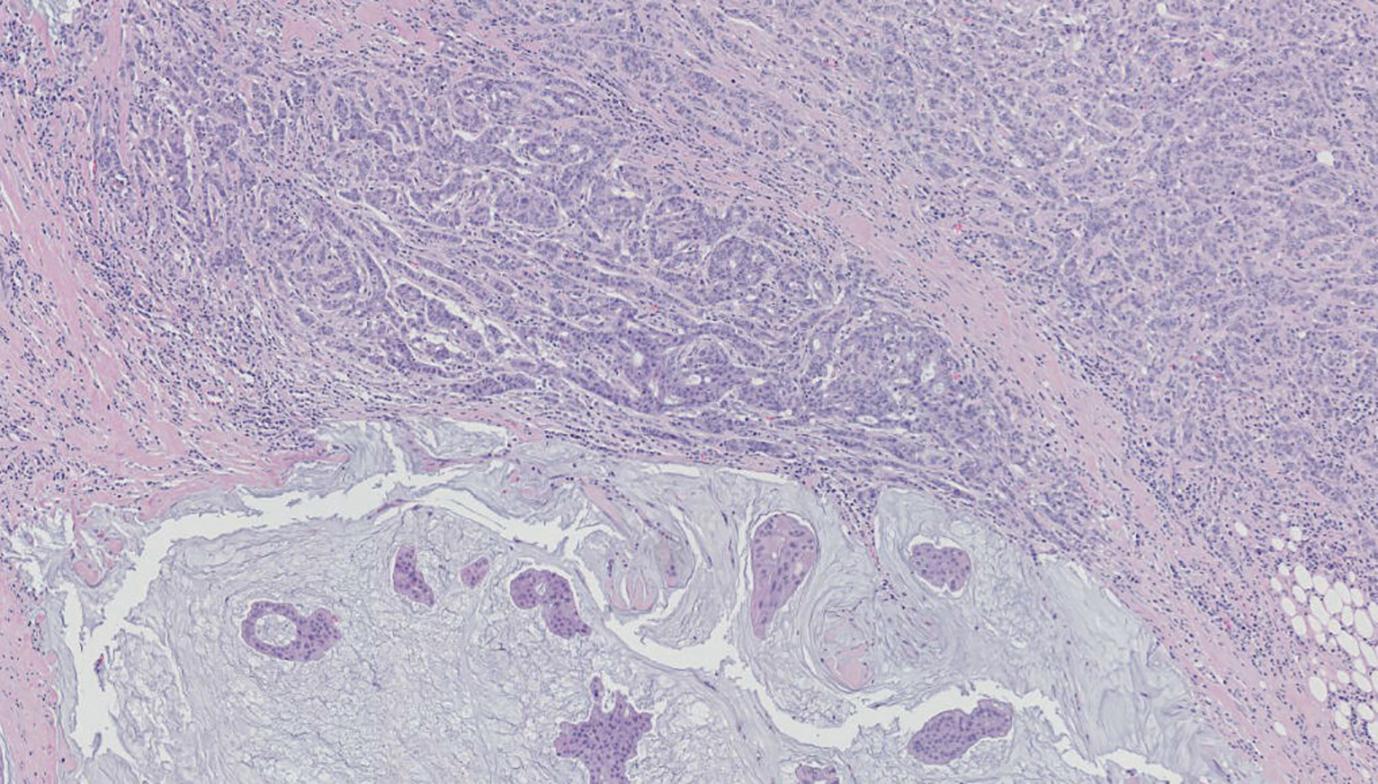
ILC is the second commonest form (5–15%) of invasive breast cancer ( Fig. 4.8 ). As in LCIS (discussed earlier), this is formed from discohesive, typically moderately sized malignant cells. Subtypes of ILC exist that have different architectural growth patterns, e.g. classical, alveolar and solid, as well as a pleomorphic form with large, atypical nuclei. ILC is typically of histological grade 2 (∼75%), ER and progesterone receptor (PgR) positive and HER2 negative. E-cadherin is typically (but not invariably) aberrant in ILC (as well as in ALH and LCIS) and may be assessed diagnostically to help to identify these lesions. However, variations in the patterns of E-cadherin immunoreactivity, and pitfalls in interpretation, are described, for both in situ and invasive disease, and present recommendations are that greater weight should be placed on the cytomorphology than immunohistochemical pattern of reactivity.
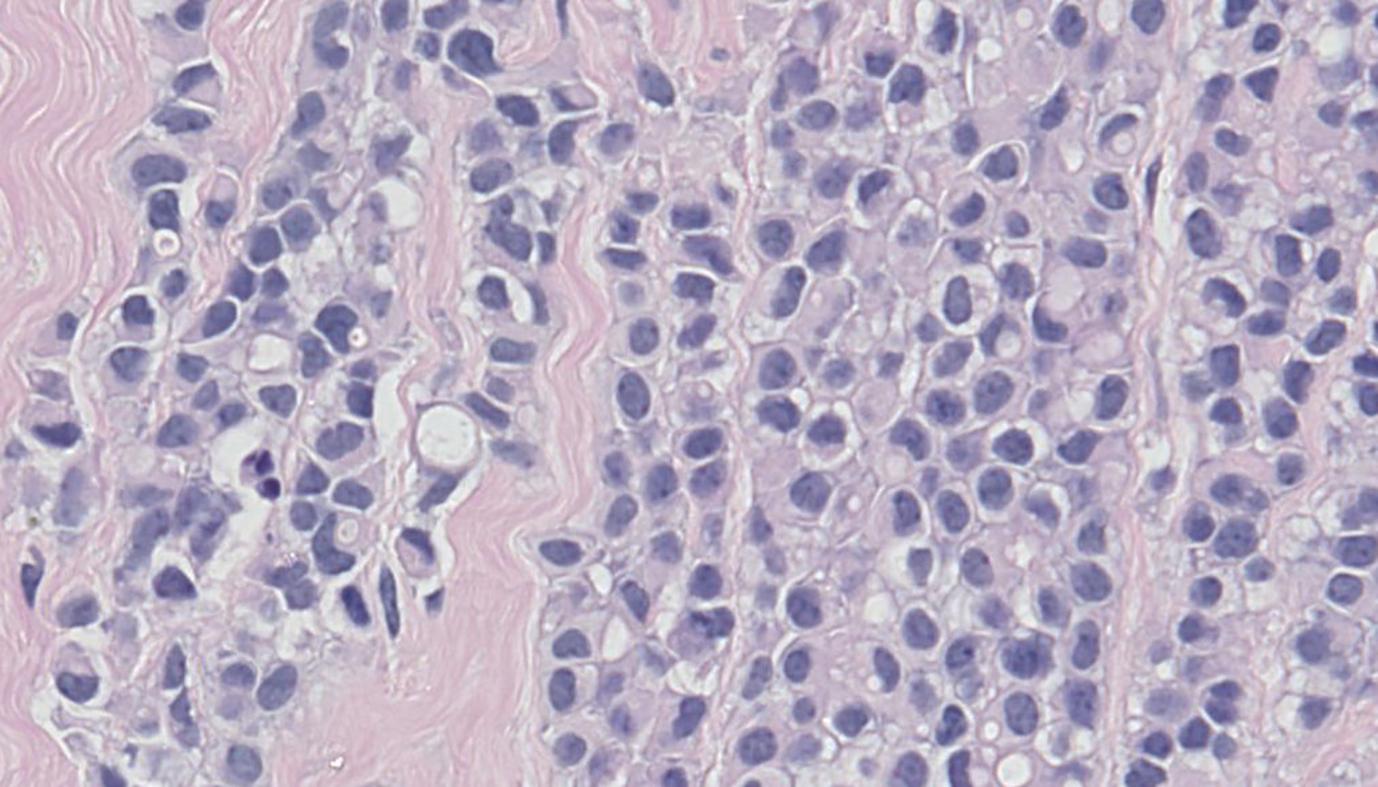
There is some evidence that ILC is particularly hormone-responsive, for example when compared to matched patients with NST tumours. ILC also shows a distinctive pattern of metastasis, preferentially spreading to the ovaries and gastrointestinal tract compared to NST lesions, rather than to lung and liver. Of note, such a pattern of metastasis is not uncommon; in one series of 481 patients with ILC, 74 (15.4%) developed metastases after a median follow-up of 46 months and 42% of these had metastases in atypical sites. (See Box 4.1 .)
![]() Rakha et al. evaluated the differences between 415 ILC and 2901 NST tumours, with a long-term follow-up (25 years). ILCs were more frequently of a lower grade (grade 2), hormone receptor-positive and larger in size and did not show LVI. Importantly, patients with ILC who received adjuvant hormone therapy had a better outcome than both those with NST tumours and those with ILC who did not receive adjuvant hormone therapy, in both univariate and multivariate analyses.
Rakha et al. evaluated the differences between 415 ILC and 2901 NST tumours, with a long-term follow-up (25 years). ILCs were more frequently of a lower grade (grade 2), hormone receptor-positive and larger in size and did not show LVI. Importantly, patients with ILC who received adjuvant hormone therapy had a better outcome than both those with NST tumours and those with ILC who did not receive adjuvant hormone therapy, in both univariate and multivariate analyses.
Metastases to lymph nodes, liver and central nervous system – no difference
Metastases to:
gastrointestinal system – 4.5% vs 0.2%
gynaecological organs – 4.5% vs 0.8%
peritoneum or retroperitoneum – 3.1% vs 0.6%
adrenal glands – 0.6% vs 0%
bone-marrow – 21.2% vs 14.4%
lung pleura – 2.5% vs 10.2%
all significantly different
Whether or not ILC is more often multicentric and/or bilateral than other types is contentious, despite it being widely reported in the literature (some series report an incidence of contralateral breast cancer of 20.9% compared with 11.2% for patients with NST lesions). What is more established, however, is that ILC may be more difficult to identify radiologically and to assess mammographically, particularly with regards to accuracy of size measurement.
There are a large number of other special-type tumours, most of which have an incidence of <5%. These include forms that have an excellent prognosis (e.g. tubular [ Fig. 4.9 ] and cribriform carcinomas [invariably grade 1]) and good-prognosis mucinous cancers (usually grade 1 or 2 but occasional high grade forms may be recognised) ( Fig. 4.10 ). Other tumour types are associated with additional specific features, such as invasive micropapillary carcinoma which has a propensity for LVI. Some types, such as metaplastic carcinoma, show mesenchymal and/or squamous differentiation but vary widely in appearances and in prognosis (despite being triple negative), from high-grade spindled cell patterns and squamous carcinomas with typically poor outcome through to low-grade adenosquamous and fibromastosis-like carcinomas, both of which have a low risk of metastatic spread but a significant local recurrence risk if inadequately excised.
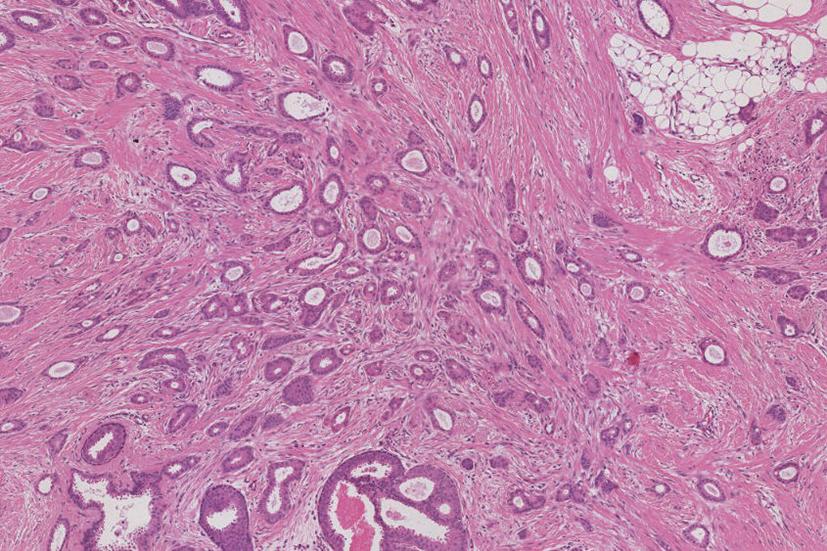
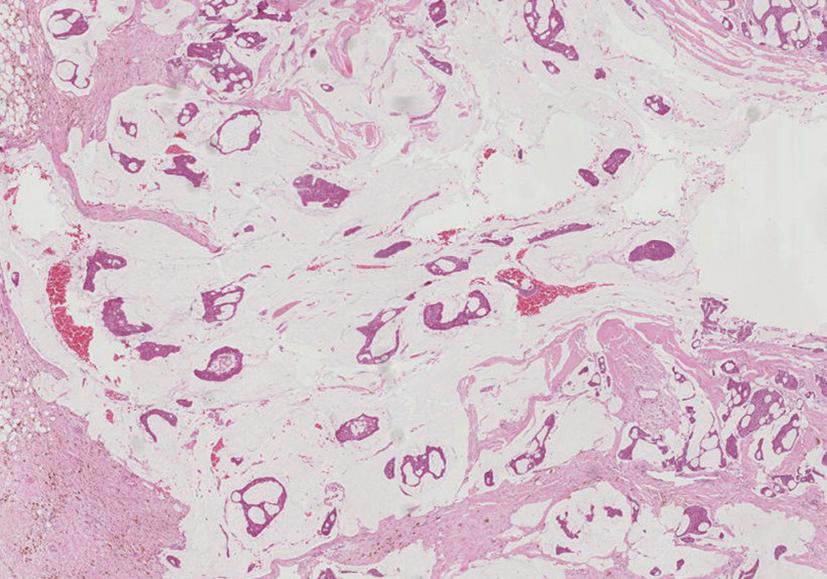
The updated World Health Organization (WHO) classification of tumours in 2019 modified the categorisation of some breast carcinoma tumour types, with some lesions that were previously considered as separate special type that have been reclassified as variants of NST. The most controversial of these is, perhaps, medullary/medullary-like carcinoma, which is no longer regarded as a stand-alone special type but as a form of NST with abundant tumour-infiltrating lymphocytes (TILs). This lesion has invariably been problematic to classify reproducibly and with variation in its reported prognosis, from excellent through to only somewhat better than node- and grade 3-matched NST lesions. Other entities that are now regarded as NST variants are the exceptionally rare oncocytic, sebaceous, lipid-rich and glycogen-rich clear cell carcinomas. Apocrine, invasive papillary and invasive solid papillary carcinomas may all also be identified histologically.
Finally there is a range of salivary-gland-like and other very rare breast carcinomas that includes adenoid cystic, secretory, acinic cell, mucoepidermoid, mucinous cystadenocarcinoma, tall cell carcinoma with reversed polarity and others. Some of these have specific genetic abnormalities, such as fusion genes, which can be assessed for diagnostic purposes in problematic cases. However, for many of these rare lesions, both their prognosis and optimal clinical management remain unclear.
Histological grade is a proven prognostic value across all invasive tumour types and should be reported in all invasive breast cancers.
![]() Elston et al., in their seminal paper, described the Nottingham Grading System, demonstrating the clinical importance of histological grade in determining prognosis in 1831 patients in the Nottingham/Tenovus Primary Breast Cancer Study. This system of grading is internationally recognised and recommended for the routine assessment of grade of all invasive breast cancers.
Elston et al., in their seminal paper, described the Nottingham Grading System, demonstrating the clinical importance of histological grade in determining prognosis in 1831 patients in the Nottingham/Tenovus Primary Breast Cancer Study. This system of grading is internationally recognised and recommended for the routine assessment of grade of all invasive breast cancers.
In essence, the grade of a tumour reflects its degree of differentiation and its proliferative capacity. It is a composite score of three features (tubule/acinar/glandular formation; nuclear atypia/pleomorphism; and mitotic count in a given field area; Fig. 4.11 ), each of which is scored from 1 to 3. The three scores are added together to yield a total from 3 to 9. Grade 1 tumours overall score between 3 and 5; grade 2 lesions are those with scores of 6 or 7; and grade 3 cancers score 8 or 9 ( Figs. 4.6 and 4.11 ). Histological grade is associated with long-term prognosis; patients with grade 1 carcinomas have a 93% chance of surviving 10 years after diagnosis, whereas in patients with grade 3 cancers this is reduced to 70%. Grade has consistently been demonstrated to be associated with breast cancer-specific and disease-free survival and this remains true both overall and in subgroups based on tumour size and LN stage, as well as being an independent prognostic factor in multivariate analysis.
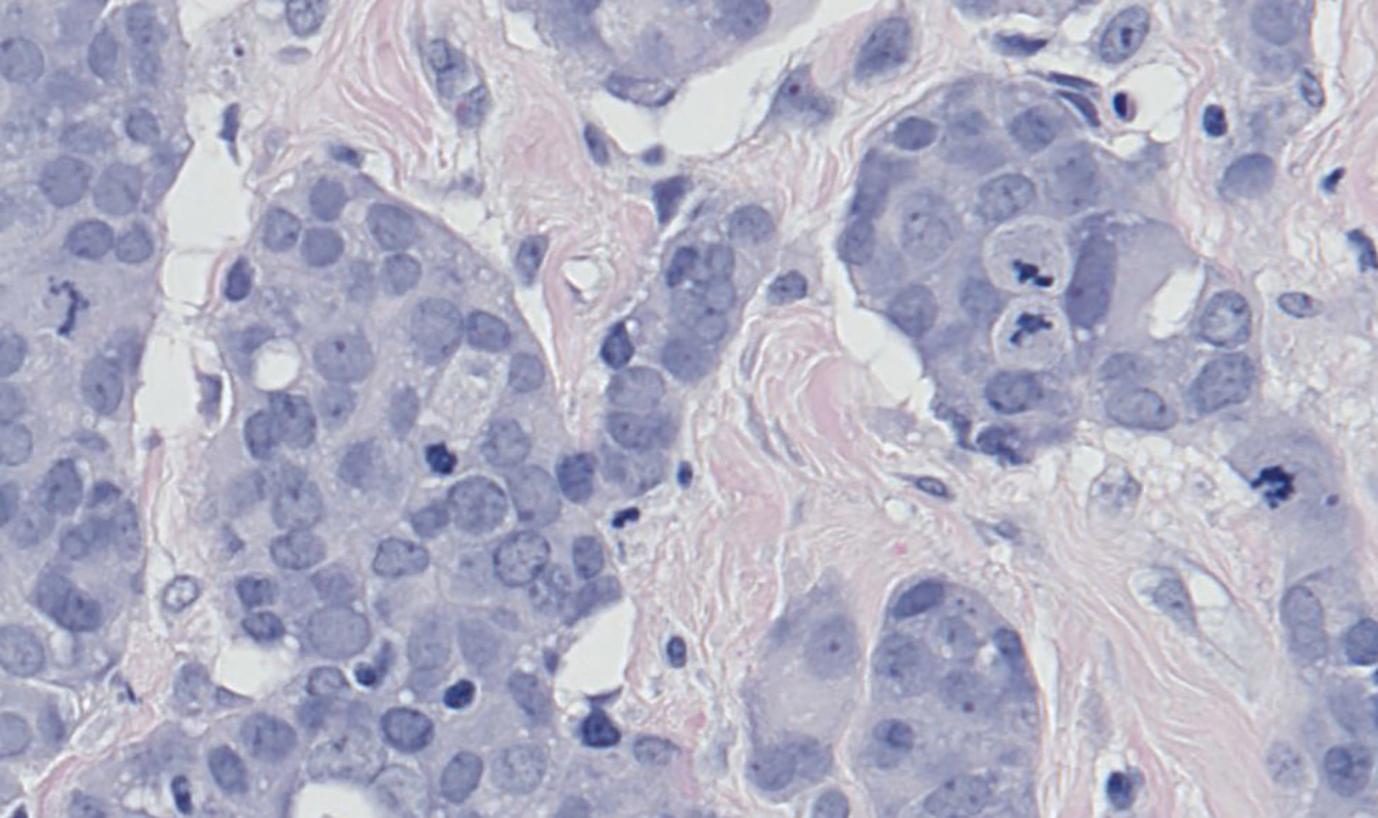
Grade is also assessed, and should be reported, on preoperative core needle biopsies (CNBs), where it can be used to guide treatment planning. The caveat is that grade on CNB does not always equate to that in the excision specimen; the core biopsy grade is more often an underestimate of the grade in the excised carcinoma rather than an overestimate, most often due to under-representation of the areas of greatest mitotic frequency in the small portion of the tumour present in the CNB. Nevertheless, CNB grade matches that of the excised tumour in approximately 67% of cases in the ‘routine’ setting, with 84% of grade 3 tumours being accurately assigned as such on the core biopsy specimen. This has importance for selection of patients, along with receptor status, for whom neoadjuvant chemotherapy (NACT) may be recommended.
Become a Clinical Tree membership for Full access and enjoy Unlimited articles
If you are a member. Log in here